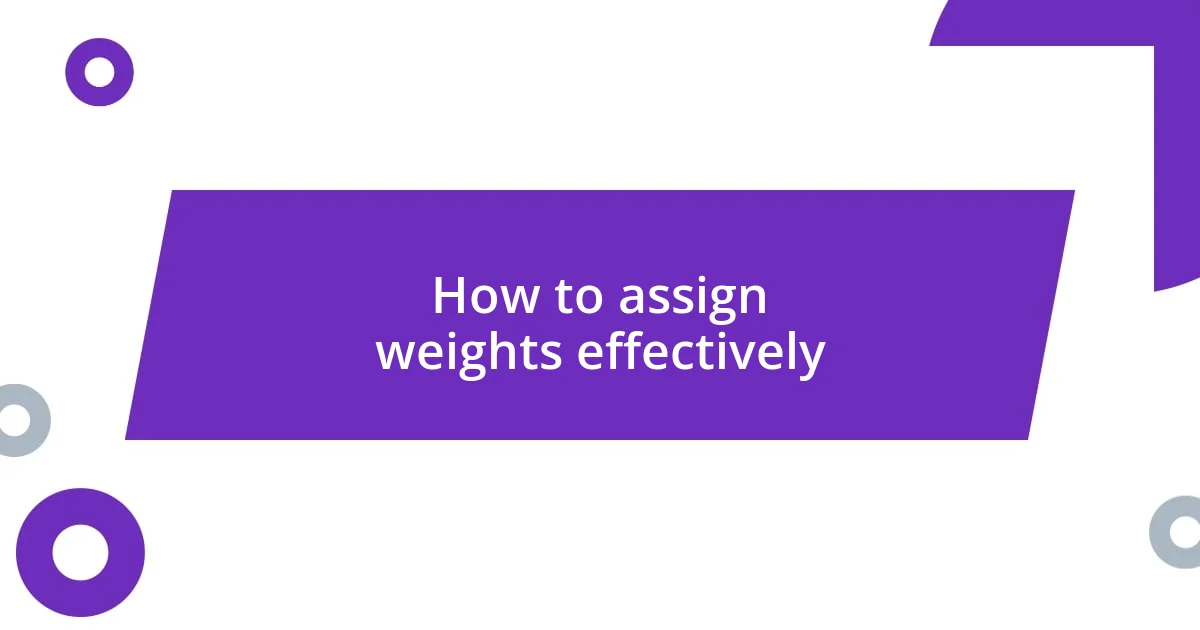Key takeaways:
- Weighted criteria help prioritize decision-making factors based on personal values, leading to choices that align with individual goals.
- Engaging in collaborative discussions and periodically reassessing criteria enhances decision effectiveness and addresses changing priorities.
- Maintaining simplicity in the weighting process prevents confusion, while adjusting weights based on diverse perspectives can improve decision outcomes.

Understanding weighted criteria
Weighted criteria are a fundamental tool for decision-making, allowing us to prioritize different factors based on their importance. I remember a time when I had to choose between two job offers. I created a weighted criteria chart to compare aspects like salary, company culture, and growth opportunities. This process illuminated my values and guided me toward the decision that truly aligned with my career goals.
When considering weighted criteria, it’s essential to ask: how do I determine what matters most to me? Each factor you assign a weight to often reflects personal beliefs and experiences. For instance, if you value work-life balance over salary, you’d weight that factor more heavily, shaping a decision that resonates with your lifestyle and emotional well-being.
I’ve often found that adjusting the weights can feel like recalibrating one’s internal compass. For example, after a frustrating job experience, I realized I needed to prioritize company culture significantly more. This insight not only shifted my approach to job hunting but also deepened my understanding of what truly fulfills me in a workplace setting. Have you ever felt the need to reassess your priorities in a similar way?

Importance of weighted criteria
Using weighted criteria significantly enhances our decision-making process because it helps clarify what truly matters in any given situation. I recall a time when planning a vacation; my family had different interests. By assigning weights to criteria like cost, activities, and relaxation, we came up with a destination that met everyone’s expectations. It was fascinating to see how each person’s perspective shaped the overall decision, highlighting the power of weighted criteria in fostering collaboration and understanding.
- It aids in prioritizing needs and values.
- Encourages thoughtful analysis rather than impulse decisions.
- Facilitates open discussions about differing preferences within a group.
- Ensures that the final choice aligns closely with personal or collective goals.
- Provides a structured approach to complex choices, making decisions less daunting.
Revisiting my criteria recently as I planned my next vacation reminded me how crucial weights are. This time, I found myself placing a higher priority on eco-friendly practices because they resonated with my growing concern for sustainability. I was pleasantly surprised at how this shift didn’t just affect my choice of destination, but also enriched my travel experience overall. This evolution in my approach reflects how dynamic and personal the process can be.

Evaluate criteria for your needs
When evaluating criteria for your needs, it’s essential to start by identifying what truly matters to you in a given scenario. I remember when I had to select a new fitness program; I listed aspects like workout intensity, flexibility, and community support. This exercise not only clarified my priorities but also helped me articulate what I wanted from the experience, making the decision process much more manageable.
It can be tempting to rush this evaluation, but taking the time to reflect and adjust your weights is crucial. For instance, while initially, I prioritized flexibility, I later found that community interaction motivated me more than I’d realized. By reassessing my criteria, I not only chose a program that fit my schedule but also connected with others who shared my fitness goals. Isn’t it fascinating how deeply understanding your own needs can transform a seemingly mundane decision into a more fulfilling experience?
As you dive into the nitty-gritty of your criteria, consider how your lifestyle impacts your choices. For instance, when I was upgrading my home office, I focused on comfort, ergonomics, and aesthetics. However, after working for a while, I realized the importance of technology and organization too. Each experience taught me to refine my criteria, ensuring they genuinely align with how I work and feel at home.
| Criterion | Description |
|---|---|
| Importance | How critical this factor is to your specific situation. |
| Adaptability | How well you can adjust this criterion as circumstances change. |
| Alignment | How closely this factor reflects your values and personal goals. |
| Impact | The extent to which this criterion influences the overall decision. |

How to assign weights effectively
To assign weights effectively, I find it helpful to reflect on my core values first. For example, when I was choosing an educational course, I rated factors like course content, instructor reputation, and career prospects. By focusing primarily on what would genuinely benefit my personal growth and align with my long-term ambitions, I could assign more weight to those criteria that echoed my aspirations. This intentionality in weighting often leads to more satisfying decisions.
Another strategy I use is to involve others in the decision-making process. When my friends and I were planning a group trip, we each ranked aspects like accommodation, activities, and budget. Engaging in discussions about why we preferred certain criteria helped us to clarify our individual priorities. This collective approach not only brought us closer but also ensured that the weights we assigned reflected a balanced perspective of the whole group.
Lastly, I experience that periodic reassessment of weights leads to more informed outcomes. For example, while I initially weighted price heavily during my last car purchase, I discovered over time that safety features and fuel efficiency became more significant for me. It’s amazing how our priorities can shift with experiences and insights, prompting a natural evolution of what we deem important. Isn’t it intriguing how a small adjustment in weighting can lead to a transformative decision?

Common mistakes to avoid
A common mistake I often notice is overcomplicating the weighting process. It can be easy to get lost in a maze of too many criteria, which only leads to confusion. I recall a time when I was evaluating different job offers; instead of narrowing down to just a few key factors—like company culture and growth opportunities—I initially created an exhaustive list. It was overwhelming! Simplicity often brings clarity.
Another pitfall is failing to adjust weights after gathering feedback. I learned this the hard way while picking a software solution for my small business. I consulted a couple of colleagues but initially brushed off their input too quickly. When I finally considered their viewpoints, I realized I had undervalued features they deemed crucial for usability. Incorporating diverse perspectives can dramatically enhance your decision’s effectiveness.
Lastly, not periodically revisiting your criteria is a mistake I believe can lead to stagnation. Life changes us and so do our priorities. After joining a few community projects, I discovered that I now value collaboration far more than I did before. If I hadn’t taken the time to reassess my criteria, I might have missed out on meaningful opportunities that align with my evolved goals. Don’t you wonder what insights you might miss by sticking to outdated priorities?














